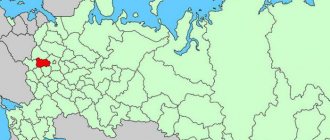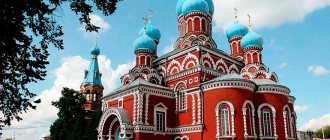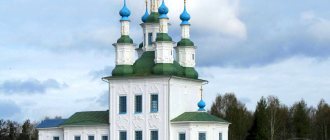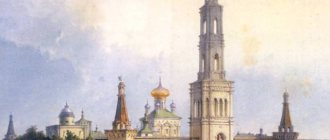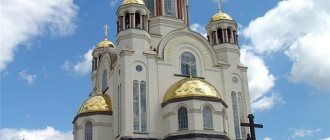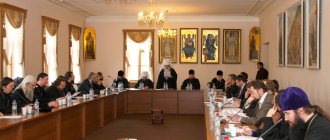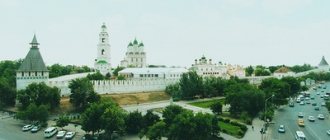| Khabarovsk Transfiguration Cathedral |
Khabarovsk and Amur Diocese of
the Amur Metropolis of the Russian Orthodox Church
- Diocesan administration: Russia, 680021, Khabarovsk, st. Leningradskaya, 65
- Tel., 31-01-31
- Official website: (website of the Amur Metropolis)
- Canonical territory: Khabarovsk GO; Amursky, Khabarovsk, Nikolaevsky, Okhotsky, Ayano-Maisky and Tuguro-Chumikansky districts of the Khabarovsk Territory
- Cathedral: Transfiguration in Khabarovsk
- On the map: Yandex.Map, Google map
The territory of the present Khabarovsk Territory began to be developed by Russians in the 17th century.
Together with them, Orthodoxy appears here; these lands are part of the Tobolsk diocese. According to the Treaty of Nerchinsk in 1689, the Russians left the Amur region, but the Treaty of Aigun in 1858 returned the left bank of the Amur to Russia. Meanwhile, the Russian Far East was part of the Irukst (since 1721) and then Kamchatka (since 1840) dioceses. In 1898, the Holy Synod divided the latter into Vladivostok and Blagoveshchensk, and the territory of the modern Khabarovsk Territory became part of both. During the revolutionary hard times, both dioceses were defeated and suppressed - the first in 1934-1935, the second in 1936. In the 1920s, the first bishops with the title of Khabarovsk were appointed as vicars of the Annunciation diocese. By the beginning of the Great Patriotic War, there were no functioning churches in Khabarovsk; only chapels remained in the cemetery and near the station. During the war years, the state took a step towards the believers and two churches were opened in Khabarovsk: Rozhdestvensky and Alexander Nevsky in the Krasnoflotsky village, which came under the jurisdiction of the Novosibirsk ruler. On January 25, 1945, a resolution of the Holy Synod was adopted on the establishment of the Khabarovsk and Vladivostok diocese within the Primorsky and Khabarovsk territories, Kamchatka, Sakhalin and the Kuril Islands. The parishes of the Yakutsk and Chita vicariates of the Irkutsk diocese were also transferred under the care of the Bishop of Khabarovsk. Initially, Khabarovsk was planned as the cathedral city, but soon after the diocese began its activities, the department was moved to Vladivostok [1]. The diocese maintained independent administration until 1949, after which the dowager diocese was governed by the Irkutsk hierarchs. From 1943 to 1948, 10 parishes were opened within the diocese, after which, until the 1980s, all numerous requests from believers to open new parishes were rejected by the authorities.
Since the late 1980s, the process of revival of the Far Eastern dioceses has begun. On July 19, 1988, a resolution was adopted to restore the Khabarovsk and Vladivostok diocese, which included the Khabarovsk and Primorsky territories, the Amur, Sakhalin, Magadan and Kamchatka regions. On January 31, 1991, the Vladivostok and Magadan dioceses were separated from its composition. On December 28, 1993, the Blagoveshchensk diocese was separated from Khabarovsk. Finally, on October 7, 2002, the Birobidzhan diocese was separated from the Khabarovsk diocese. At the same time, the borders of the diocese coincided with the borders of the Khabarovsk Territory.
On October 5, 2011, the independent Amur diocese was separated from the Khabarovsk diocese. At the same time, the Khabarovsk city district and the Amur, Bikinsky, Vyazemsky, Sovetskogavansky, and them remained under the jurisdiction of the Khabarovsk department. Lazo, Nanaisky, Khabarovsk, Nikolaevsky, Okhotsky, Ayano-Maisky and Tuguro-Chumikansky districts in the north and south of the Khabarovsk Territory. At the same time, within the last four districts, the local Nikolaev vicariate was established [2].
On October 6, 2011, the Amur Metropolis was formed within the Khabarovsk Territory, which includes the Amur and Khabarovsk dioceses. The head of the metropolitanate was determined to be the Khabarovsk bishop [3].
On October 21, 2021, a number of districts in the southeast of the region were transferred to the newly established Vanino diocese, after which the Khabarovsk city district, as well as the Kharabovsky and Amur districts remained under the direct jurisdiction of the Khabarovsk diocese. The Nikolaev vicariate on the territory of the Nikolaev, Okhotsk, Ayano-Mai and Tuguro-Chumikan regions was also retained under the jurisdiction of the Khabarovsk ruler.
Historical names
- Khabarovsk (vicarious, 1925 - ?)
- Khabarovsk and Vladivostok (January 25, 1945 - October 22, 1990)
- Khabarovsk and Blagoveshchensk (October 22, 1990 - December 28, 1993)
- Khabarovsk and Priamurskaya (since December 28, 1993)
Statistics
- con. 1948 - 10 parishes: Alexander Nevsky and Rozhdestvensky in Khabarovsk, one each in Vladivostok, Blagoveshchensk, Voroshilov, Lazo, Magdagachi, Svobodny, Spassk, Suchan [4].
- January 1, 1958 [5] - 13 registered temples/houses of worship.
- OK. July 19, 1988, at the time of revival - 15 parishes, two deaneries (Khabarovsk and Primorsk), 26 clergy [6]
- OK. 2004 - 46 parishes; 48 clergy (42 priests, 6 deacons); 26 Sunday schools [7]
- December 31, 2005 [6] - 45 parishes, 1 monastery, 6 chapels, 57 full-time priests, 8 deacons.
- OK. 2010 - religious associations in the Khabarovsk Territory: Jehovah's Witnesses 77 (7 organizations and 70 groups); Orthodox 55 (48 organizations and 7 groups); “Christians of the Evangelical Faith” 46 (32 organizations and 14 groups); Baptists 32 (17 organizations and 15 groups); Adventists 17 (11 organizations and 6 groups); Presbyterians 13 (12 organizations and 1 group); “Evangelical Christians” 9 (9 organizations); “New Apostolic Church” 8 (1 organization and 7 groups); Muslims 6 (6 organizations); Old Believers 6 (1 organization and 5 groups); Hare Krishnas 5 (1 organization and 4 groups); new religious movements 5 (5 groups); Roman Catholics 4 (3 organizations and 1 group); Lutheran 3 (3 organizations); methodologists 3 (3 organizations); Judaists 3 (3 organizations); Mormons 1 (1 organization); Buddhists 1 (1 organization); Bakhaev 1 (1 organization) [8]
- 2011 - population within the diocese 1,400,425 people; territory 788,600 km²; 52 parishes, 38 churches, 1 monastery, 1 seminary, 10 churches under construction; more than 80 clerics [9]
Archpastors
- Trofim (Yakobchuk) (1925)
- Nikifor (Efimov) (April 3, 1926 - April 25, 1928)
- Panteleimon (Maksunov) (1930 - February 11, 1933)
- Sschmch. Herman (Kokkel) (July - September 1931) bishop. Nikolsko-Ussuriysky
1933 - 1945 - stopped
- Bartholomew (Gorodtsov) (July 10, 1947 - 1948) v/u, archbishop. Novosibirsk
1949 - 1988 - widowed, ruled by Irkutsk bishops
- Vadim (Lazebny) (January 31 - December 27, 1991) senior, ep. Irkutsk
№15 (624) / April 11 '11
Diocese
From the history of the diocese
The beginning of the history of the Orthodox Church in the Amur region can be considered the establishment of the first diocese in Siberia with a see in Tobolsk, which occurred in 1620, 40 years after the conquest of Siberia by the Russians. This event greatly contributed to the penetration of the light of the Gospel of Christ further to the east. Soon, by the middle of the 17th century, together with the Cossack pioneers, Orthodoxy came to the banks of the Amur. In 1649 - 1653, the Cossacks, led by Ataman E.P. Khabarov crossed almost the entire course of the great river and accepted the peoples inhabiting its banks into Russian citizenship. In the upper reaches of the Amur, they stormed the town of the local prince Albaza, located on the very border with the Qing Empire, and settled in it. The Cossacks did not think of finding themselves in an unknown country without priestly care, so Khabarov’s army had a floating church in honor of the All-Merciful Savior. Soon the Albazin fortress became the center of the Amur region. It was there in 1666 that Elder Hieromonk Ermogen transferred from the Kirensky fort the miraculous icon of the Mother of God “The Word became Flesh”, which became the first shrine of the Amur region and from that time received the name “Albazin”.
As a result of several sieges of Albazin by Chinese troops in 1684-1685 and the signing of the Treaty of Nerchinsk with the Qing Empire in 1689, the vast territory of the Albazin Voivodeship was taken from Russia. After this, the spread of Orthodoxy in the Amur region stopped for more than a century and a half. Although in the very lower reaches of the Amur and on the shores of the Sea of Okhotsk, Russian villages were preserved and, accordingly, the Orthodox faith was preserved in them.
The settlement of lands north of the Amur by Russian people continued, and in the 18th century the Far Eastern “capital” of Russia moved to Okhotsk. And the 19th century became a turning point in the development of the Amur region by Russians. In the summer of 1849, the expedition of G.I. Nevelskoy entered the mouth of the Amur, where on August 1, 1850, it raised and installed the Russian flag and founded the Nikolaevsky post, which soon became the city of Nikolaevsky. After rafting on the Amur expeditions N.N. Muravyov in 1854 and 1855, Russian peasant settlers flocked to the lower reaches of the great river in large numbers.
In 1858, the historic Aigun Treaty was concluded with China, which returned the Amur region to Russia. The newly acquired vast lands were included in the already colossal Kamchatka, Kuril and Aleutian diocese. And in 1859, the episcopal see was moved to the banks of the Amur, to Blagoveshchensk. The diocese was headed at that time, being in the rank of archbishop, by Holy Equal-to-the-Apostles Innocent (Popov-Veniaminov), later (from 1868) by the Metropolitan of Moscow. He became the first Amur bishop.
After 1858, new military posts began to be built one after another in the Russian Far East, which very quickly turned into cities. Thus, Khabarovsk was founded in 1858, Vladivostok in 1860, and Nikolsk in 1866. Over time, among all the Far Eastern cities, Khabarovsk became more and more important, which in 1884 became the center of the newly formed Amur Governor-General. Blagoveshchensk still remained the ecclesiastical center of the Far East.
At the end of 1869, a royal decree was signed on the separation of an independent Yakut diocese from the Kamchatka, Kuril and Aleutian diocese. And in 1870, after the sale of Alaska to the United States, an independent Aleutian diocese was separated from the Kamchatka diocese. Even after the separation of the Yakut and Aleutian dioceses, the territory of the Kamchatka diocese remained huge. And in 1899 it was divided into two autonomous dioceses - the Amur-Blagoveshchensk and Vladivostok-Kamchatka.
After the revolution of 1917, the persecution of the Church by the militant atheists who came to power increased every year throughout the country.
By 1934, there was not a single functioning church and not a single registered clergyman left in the Khabarovsk Territory.
The revival of the independent Khabarovsk-Vladivostok diocese symbolically coincided with the celebration of the millennium of the Baptism of Rus' in 1988.
Since 1990, the diocese began to be called Khabarovsk and Blagoveshchensk, because The Vladivostok and Primorsky diocese was separated from its composition.
In 1991, Bishop Innocent (Vasiliev) was appointed to the Khabarovsk and Annunciation Sees. Under him, in 1993, the Blagoveshchensk and Tynda diocese gained independence. From then to this day, the Khabarovsk bishops bear the title of Khabarovsk and Amur bishops.
On the territory of the diocese there are 52 parishes, 38 churches, 1 monastery, 1 seminary, 10 churches under construction.
Diocese address: Russia, 680021, Khabarovsk, st. Leningradskaya, 65. Phone: .
Archbishop of Khabarovsk and Amur Ignatius
- Date of birth: March 25, 1956
- Date of consecration: March 29, 1998
- Angel Day: May 13th.
Biography.
- Born in Irkutsk.
- In 1978 he graduated from the Faculty of Physics of Irkutsk State University, from 1978 to 1980 he served in the ranks of the Soviet Army. In 1980-1983 worked as an engineer at the East Siberian Energy Institute, and since 1983 headed the laboratory of medical cybernetics at the All-Union Scientific Center for Surgery.
- In 1988 he received Holy Baptism. In March 1990, he joined the brethren of the Holy Spiritual Monastery in Vilnius. He served as librarian, dean, trustee and confessor of a boarding school in Vilnius.
- On September 27, 1990, he was ordained a deacon by Archbishop Chrysostom of Vilna and Lithuania.
- On April 13, 1992 he was tonsured a monk, and on May 10 he was ordained a hieromonk.
- In 1993 he graduated from the Moscow Theological Seminary in absentia.
- In September 1992, he was appointed dean of the Holy Spiritual Monastery.
- On November 2, 1997, he was elevated to the rank of abbot, and on March 1, 1998, to the rank of archimandrite.
- On March 29, 1998, he was consecrated Bishop of Petropavlovsk and Kamchatka.
- On February 25, 2007, by decree of His Holiness Patriarch Alexy II, he was elevated to the rank of archbishop.
- In February 2008, Bishop Ignatius opened his blog on the Internet.
- By the decision of the Holy Synod of March 22, 2011 (magazine No. 15), he was appointed to the Khabarovsk and Amur departments.
Education:
- 1978 – Faculty of Physics, Irkutsk State University.
- 1993 – Moscow Theological Seminary.
- 2007 – PSTGU, diploma of specialist in theology.
Awards
- church: 2010 – Order of St. Blg. Book Daniil of Moscow II degree;
- secular: state order “For Services to the Fatherland”, II degree.
His Holiness Patriarch Kirill of Moscow and All Rus' sent congratulations to Archbishop Ignatius of Khabarovsk and Amur on the occasion of his 55th birthday anniversary
His Eminence, Most Reverend Ignatius, Archbishop of Khabarovsk and Amur
Your Eminence!
On the day of your 55th birthday, I cordially congratulate you on this significant date and prayerfully wish you strength, peace, spiritual joy and generous mercies from our Lord Jesus Christ.
Desiring to serve the One who is the Way, the Truth and the Life (John 14:6), you responded with all your soul to the Gospel call: “If anyone wants to come after Me, let him deny himself, and take up his cross, and follow Me” (Matt. 16, 24; Mark 8, 34; Luke 9, 23). Striving to fulfill the Lord’s covenant, you performed all the obediences assigned to you with zeal and responsibility. Now you have been appointed by the Holy Synod to the Khabarovsk See, where you must take care of the enlightenment of this region with the light of Christ’s faith, the spiritual and moral education of the younger generation, multiplying the fruits of the labors of the first apostles of the Far East.
In consideration of your diligent service and in connection with your 55th anniversary, I consider it fair to present you with a commemorative panagia.
Through the prayers of the Most Holy Theotokos, may the All-Merciful Lord keep you in good health for many years to come.
With love in the Lord,
KIRILL, PATRIARCH OF MOSCOW AND ALL Rus'
Icon of the Most Holy Theotokos “The Word became Flesh” (Albazinskaya)
The miraculous image “The Word became Flesh” was brought to Albazin by Hieromonk Ermogen in 1666 from the Cyrene prison. A few years later, Ermogen returned to the Trinity Monastery he founded at the Kirensky fort, and left the miraculous image in Sretensk.
His Grace Veniamin, appointed to govern the Kamchatka diocese, brought this icon to Blagoveshchensk-on-Amur in 1868, and one of his successors, Bishop Gury, established an annual celebration of the icon “The Word became Flesh” on March 9 (old style) throughout the Kamchatka diocese , as well as weekly reading of the akathist with prayer singing before this miraculous icon of the Mother of God.
Due to the fact that this image of the Mother of God depicts the womb of the Divine Child, many believers have taken root the custom of praying before him for mothers during their womb and birth illnesses. One young woman, through her negligence, suffered a premature termination of pregnancy. She awaited her death in great agony. Her husband, who deeply believed in the gracious power of the icon of the Mother of God “The Word became Flesh,” asked to pray before her for a successful outcome of the illness. The mistress heeded the fervent prayer for the suffering woman, and while reading the akathist, this young woman safely gave birth to a child.
In general, this miraculous image is reverently revered throughout the Amur region. This Albazin icon is also called by others the Sign, due to the similarity of its image with the image of the icon called the Sign.
The celebration of the icon takes place on March 22.
Works of mercy
Social activities of the convent of St. top App. Peter and Paul
- Address: s. Petropavlovka, Khabarovsk district, st. Green, 5.
- Telephone:
- Children from the orphanage in the village live in the monastery in the summer. Solnechny (from 8 to 16 years old, 3-6 people). The monastery regularly conducts educational excursions for pensioners from neighboring villages, orphanages and schoolchildren of the diocese, suspended minors from the village. Maksim Gorky. The monastery's refectory is not denied to those in need.
Youth department
- Address: Khabarovsk, st. Leningradskaya, 27, City Hospital No. 3, St. Nicholas Church.
- Website: www.dvmolodo.ru
- The department holds meetings, round tables, concerts, and numerous charity events, including collecting things for orphanages and funds for medicines for children with cancer. Volunteers from the youth department constantly visit children in the oncology department of the hospital, orphanages, and provide assistance to lonely old people.
Sisterhood at the parish of St. prpmts. Grand Duchess Elizabeth
- Address: Khabarovsk, st. Voronezhskaya, 49.
- The parish is located on the territory of the Road Clinical Hospital at the station. Khabarovsk-1. From 1999 to 2000, even before the construction of the temple, a school of sisters of mercy operated here. 30 sisters of mercy were graduated with a nursing diploma and are now working in various hospitals in the city.
Shrines of the diocese:
- a revered copy of the Albazin Icon of the Mother of God;
- revered icon of the Mother of God “Inexhaustible Chalice”;
- Icon of the Mother of God “Blessed Womb – Khabarovsk”;
- icon of St. Seraphim of Sarov with a particle of relics;
- icon of St. Innocent of Irkutsk with a veil;
- icon of St. right warrior Theodore (Ushakov) with a particle of relics;
- ark with the holy relics of the 12 Optina elders, St. Innocent of Irkutsk, St. Maxim the Greek.
Saint:
- Saint Innocent (Veniaminov) is the successor of the Cyril and Methodius tradition in the Russian Far East.
Khabarovsk Theological Seminary
It was created by the decision of the Holy Synod on June 10, 2005 due to the urgent need to develop missionary activity in the Far Eastern region. Its main tasks are the training of clergy for the dioceses of the Far East and the development of research in the field of history and methodology of Christian mission in the region. Khabarovsk Theological Seminary became the first theological educational institution of the Russian Orthodox Church to undergo the necessary procedures for licensing higher education programs according to state educational standards.
A special position in the seminar course is occupied by the area of local history, the development of which is carried out by the church history department. Already from the first year at the seminary, the history of the spread of Christianity in the Far East is studied. A missionary department has been opened, within the framework of which the research of the experience and heritage of Far Eastern missionaries and missionary centers is carried out. Particularly important in the activities of the department will be the study of the history and cultures of the peoples inhabiting the Far Eastern region. The Theological Department organizes scientific work in the field of theological research.
Diocesan departments:
- religious education;
- for relations with the Armed Forces;
- on interaction with law enforcement agencies.
Monasteries:
- monastery in honor of the Apostles Peter and Paul in the village. Petropavlovka (female).
Educational establishments:
- Khabarovsk Theological Seminary (since 2005);
- 26 Sunday schools.
Church media:
- "Orthodox Herald of the Amur Region."
- “Orthodox Calendar”, TV show.
Associations and organizations:
- Orthodox society "Holy Rus'" (since 1992);
- sisterhood, Khabarovsk.
Website of the Khabarovsk and Amur diocese: https://khveparhia.ru
In other rooms:
Geography of deaneries
- Khabarovsk:
- Khabarovsk, o. Bolshoy Ussuriysky, village. Krasnorechenskoye, Sosnovka village
- Amursk, Elban village, Litovko village
- With. Bychikha, s. Vinogradovka, village Zaozernoe, village Knyaze-Volkonskoye, Korfovsky village, Nekrasovka village, village. Petropavlovka
- Nikolaev Vicariate (Nikolayevsky, Okhotsky, Ayano-Maisky, Tuguro-Chumikansky districts):
- Nikolaevsk-on-Amur, s. Arch, p. Ayan, s. Nelkan, Okhotsk village, village. Chumikan
Khabarovsk is the center of the newly formed vicariate
The Khabarovsk diocese that exists today was established in 1925, but in those years it had the status of a vicariate, that is, it was an ecclesiastical administrative unit that was part of a larger diocese, in this case Blagoveshchensk. It was headed, as it should be in such cases, by a bishop subordinate to the diocesan ruler.
The city of Khabarovsk became the center of the new education. This state of affairs continued until 1933, when, as a result of a series of anti-religious campaigns in the Amur region, all churches without exception were closed. Only ten years later, at the height of the war against fascism, when, wanting to promote the spiritual unity of the people, the government agreed to a partial revival of religious life, the first parish in the Far East began to operate in Khabarovsk.
The Cathedral is a symbol of new times
A visible embodiment of the beneficial changes that have come in the religious life of the Far East was the construction in 2001-2004. Spaso-Preobrazhensky Cathedral in Khabarovsk. This monumental five-domed building was built with funds from voluntary donations from future parishioners, as well as a number of businesses and public organizations. The authors of the project were a group of Far Eastern architects, headed by Yuri Zhivetev. The painting of the walls and dome was carried out by a team of Moscow painters, specially invited by Bishop Vladimir.
It should be noted that the main cathedral of Khabarovsk, the cross of which rose 95 meters above the ground, is the third tallest among Russian churches. It is second only to St. Isaac's Cathedral in St. Petersburg and the Moscow Cathedral of Christ the Savior. The size of its interior is also impressive, capable of simultaneously accommodating up to three thousand people.
The Far Eastern Pilgrimage Center of the Khabarovsk Diocese, created with the blessing of Bishop Vladimir, has been operating in the premises of the cathedral for eight years. Its employees organize regular trips to visit the holy places of our country, as well as those located beyond its borders. Thanks to their efforts, many residents of Primorye had the opportunity to visit Israel and see places associated with various biblical events, as well as venerate the relics kept in the monasteries and churches of their Fatherland.
Organization of diocesan self-government
The diocese received independent rule in 1945, when the Holy Synod sent a bishop to the city of Khabarovsk, who received the title of Khabarovsk and Vladivostok. However, after four years, the leadership of the diocese was transferred to the Irkutsk Bishop.
At the end of the 80s, when new trends caused by perestroika emerged in the life of the country, and the pressure of the authorities on the church weakened significantly, the diocese of Khabarovsk and Vladivostok (as it was now called) again received the opportunity for self-government. In addition, its territory was significantly expanded and began to include, in addition to the Khabarovsk and Primorsky Territories, a number of regions: Kamchatka, Sakhalin, Magadan, Amur and Jewish Autonomous Regions.
